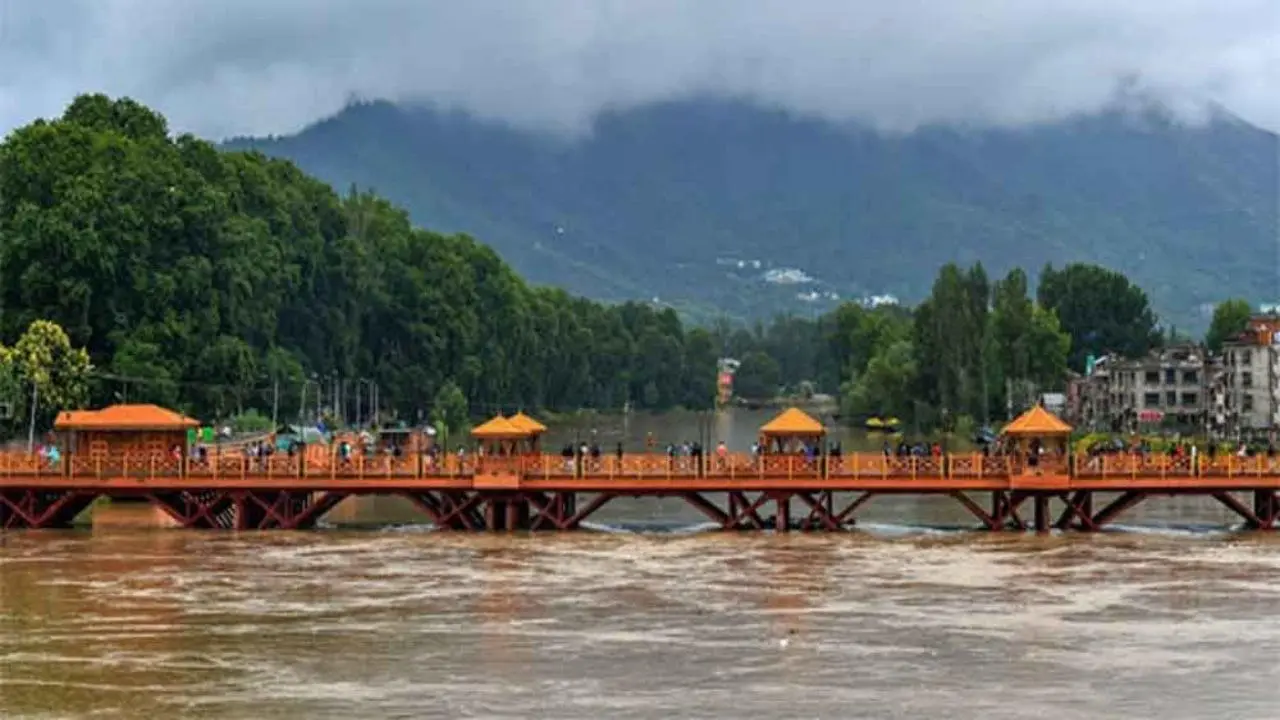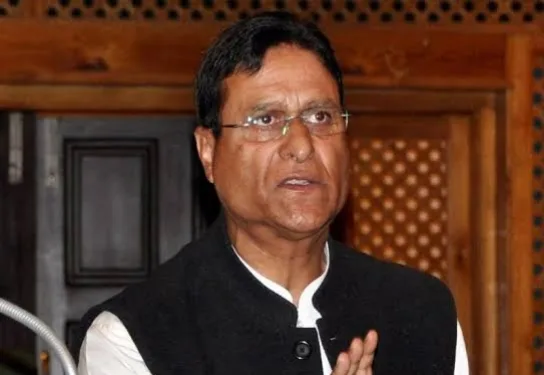Jhelum Recedes: Kashmir Flood Scare 2025 Ends, But Questions Over Preparedness Remain
By: Javid Amin | 28 Aug 2025
A Night of Fear, A Morning of Relief
For the people of Kashmir, the night of August 27–28 was one of sleepless anxiety. Heavy rainfall had swollen the Jhelum River to levels unseen in nearly a decade.
At Sangam in South Kashmir, the water level rose to 23.99 feet, well past the flood declaration mark of 21 feet. At Ram Munshi Bagh in Srinagar, too, the water crept beyond alert levels. The scene evoked haunting memories of September 2014, when relentless rains caused the Jhelum to swell beyond control, submerging entire neighborhoods of Srinagar and leaving thousands homeless.
This time, however, nature spared the Valley. By midday on August 28, the Jhelum had receded to 18 feet in Srinagar, below the danger level. Embankments held, no major breaches were reported, and the city breathed a collective sigh of relief.
“We stayed up all night watching the water rise. It felt like 2014 all over again,” said Nawaz Malik, a Rajbagh resident.
For families in Rajbagh, Bemina, Lal Chowk, and Mehjoor Nagar, the night was a déjà vu of trauma. Many had prepared emergency bags, shifted valuables to upper floors, and parked vehicles on higher ground.
The morning brought calm—but also renewed questions about Kashmir’s flood preparedness.
What Changed Overnight?
The dramatic turnaround came thanks to a let-up in rainfall. Meteorologists confirmed that nearly 90–100 mm of rain fell in South Kashmir within 24 hours, pushing the river to alarming levels. But by dawn, the skies cleared, allowing the river to stabilize.
Officials of the Irrigation and Flood Control Department said:
-
24/7 monitoring of 150 vulnerable spots was carried out.
-
Emergency control rooms were activated.
-
Rescue teams remained on standby, though no large-scale evacuations were required.
-
Early warning alerts and public announcements kept residents prepared.
This coordinated response marked a stark difference from 2014, when delayed warnings and lack of coordination amplified the disaster.
Trauma That Doesn’t Fade: Kashmir’s Emotional Undercurrent
For residents, the psychological scars of 2014 remain raw. That year, the Jhelum reached 34.7 feet at Sangam, breaking embankments and swallowing Srinagar for weeks.
Thousands lost homes, livelihoods, and loved ones. Even a decade later, many residents describe themselves as “flood orphans”, with their lives permanently altered.
This week’s flood scare reopened those wounds. Social media was filled with anxious updates, photographs of rising waters, and prayers for safety. Parents recalled how their children had to be rescued on makeshift boats in 2014. Shopkeepers worried about losing merchandise again. Students feared losing books, records, and schoolwork.
“Every time the Jhelum rises, our hearts sink,” said Farhat Jan, a teacher in Bemina. “We don’t just see water—we see our past drowning all over again.”
Omar Abdullah Calls for Urgent Flood Review
As the Valley exhaled in relief, Chief Minister Omar Abdullah issued a strong statement. He warned that Kashmir had “narrowly escaped disaster this time” and could not afford complacency.
“Just two days of rain brought us to the brink,” he said. “In 2014, it took six days. We cannot live like this every year.”
Abdullah demanded a comprehensive review of post-2014 flood measures, asking pointed questions:
-
💰 Where did the funds go? Billions were sanctioned for flood prevention, but little is visible on the ground.
-
🏞️ Was the Jhelum’s carrying capacity increased? Planned dredging and widening remain incomplete.
-
🛶 What mitigation systems exist? Are early warning systems, embankments, and sluice gates functioning as promised?
His statement struck a chord across Kashmir, where citizens have long accused successive governments of mismanaging flood funds and prioritizing short-term repairs over sustainable planning.
What Officials Say
The Divisional Commissioner of Kashmir defended the administration, noting that:
-
The Jhelum touched 10-year high levels, yet embankments held.
-
Continuous surveillance at critical points prevented breaches.
-
Relief camps and emergency supplies were prepared, though not needed.
Officials acknowledged, however, that long-term flood prevention remains incomplete. While dredging has been carried out in patches, experts argue it has not significantly enhanced the river’s carrying capacity.
Why Kashmir Floods So Easily: The Science
Kashmir’s geography makes it particularly vulnerable to floods.
-
The Jhelum River snakes through the Valley in a shallow basin, making it prone to overflow.
-
Rapid urbanization in floodplains has blocked natural water channels.
-
Climate change is increasing the frequency of cloudbursts and extreme rainfall.
-
The Dal Lake and Wular Lake wetlands, which once absorbed excess water, are shrinking due to encroachment.
According to environmental experts, even moderate rainfall now risks urban flooding. Unless wetlands are restored and flood channels expanded, Kashmir will face recurring scares every monsoon.
Gaps in Post-2014 Flood Mitigation
Despite promises, several issues remain unresolved:
-
Incomplete Dredging: Only partial dredging of the Jhelum has been done, with contractors citing lack of funds and logistical challenges.
-
Encroachment: Illegal constructions on floodplains have reduced water absorption capacity.
-
Weak Infrastructure: Embankments are patched annually, but few are structurally reinforced.
-
Lack of Transparency: Citizens remain in the dark about how much money was spent, where, and with what results.
-
Preparedness Gap: While alerts are better now, community-level disaster training remains minimal.
The Way Forward: Building a Resilient Kashmir
Experts recommend a multi-pronged approach:
-
Dredging & widening the Jhelum and its tributaries.
-
Restoring wetlands like Hokersar and Wular to act as natural flood basins.
-
Strict action against encroachments on riverbanks and floodplains.
-
Climate-adaptive infrastructure, including stronger embankments and flood-resistant housing.
-
Community-based disaster drills to prepare families, schools, and traders.
-
Transparent audits of all post-2014 flood funds and projects.
Lessons from This Week
The Jhelum flood scare of 2025 was not a disaster, but it was a wake-up call. It showed that:
-
Preparedness matters: Early warnings and surveillance prevented panic.
-
Nature is unpredictable: Just two days of rain can put half a valley on edge.
-
Trust deficit persists: Citizens still doubt whether governments are doing enough.
The Valley cannot afford to wait for another 2014-scale catastrophe to demand answers.
Conclusion
The receding Jhelum may have brought relief, but it also brought responsibility. Kashmir stands at a crossroads: either continue with short-term firefighting or commit to long-term resilience.
As Omar Abdullah said, “We cannot live like this every year.” The floods of 2014 taught Kashmir a painful lesson. The floods of 2025, even though averted, are a reminder that the Valley must prepare, not just pray.




